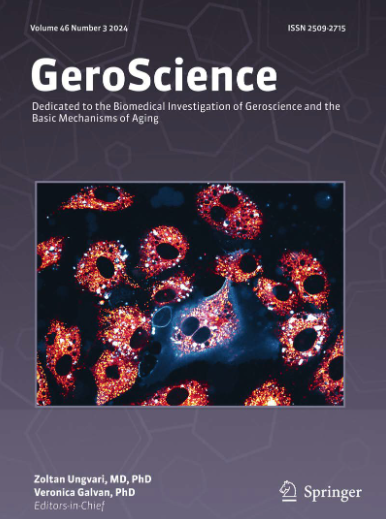雷帕霉素短期抑制mTOR可改善老年男性心脏和内皮功能:一项概念验证的初步研究。
IF 5.4
2区 医学
Q1 GERIATRICS & GERONTOLOGY
引用次数: 0
摘要
在动物模型中,雷帕霉素(RAPA)和相关的mtor抑制剂已被证明可以促进健康衰老(2-10),并且在老年人中通常是安全且可耐受的(11-13)。然而,评估它们对人类特定年龄相关病理的影响的研究是有限的。由于在临床前研究中已经报道了RAPA治疗对心血管功能的改善(5,9,10,14 -17),我们假设RAPA对人类可能同样有效。为此,我们进行了一项试点“概念验证”试验,以检验RAPA对心血管和内皮功能的影响,这些功能已知会随着年龄的增长而下降(18,19)。我们假设RAPA会对男性心血管产生有益的影响。一组无已知心脏病的老年男性受试者(年龄70-76岁)被纳入开放标签研究,接受1 mg RAPA/天,持续8周。为了评估心血管功能,在干预开始前和治疗8周后进行两次心脏MRI (CMR)检查。采用激光多普勒血流仪(LDF)检测干预前和RAPA治疗4周和8周后皮肤、内皮依赖性、局部热充血反应,检查内皮功能(1)。在所有6名受试者中,经过8周的RAPA治疗,透射血流量、峰值血流速率和最大血加速均有统计学意义的改善,内皮功能也有改善。因此,发现RAPA可改善心脏和内皮功能,并支持未来在健康老年人以及舒张功能和内皮功能受损患者的更大队列中进行安慰剂对照研究(20,21)。本文章由计算机程序翻译,如有差异,请以英文原文为准。
Short-term mTOR inhibition by rapamycin improves cardiac and endothelial function in older men: a proof-of concept pilot study.
Rapamycin (RAPA) and related mTOR-inhibitors have been shown to enhance healthy aging in animal models (2-10) and to be generally safe and tolerable in older people (11-13). However, studies to assess their effects on specific age-related pathologies in humans are limited. Since improvements in cardiovascular function with RAPA treatment have been reported in preclinical studies (5, 9, 10, 14-17), we posited that RAPA could be similarly efficacious in humans. Towards this end, we performed a pilot "proof of concept" trial to examine RAPA's effects on cardiovascular and endothelial functions that are known to decline with age (18, 19). We hypothesized that RAPA would elicit beneficial cardiovascular effects in men. A cohort of older male subjects with no known cardiac disease (ages 70-76 years) were enrolled in the open-label study and received 1 mg RAPA/day for 8 weeks. To assess cardiovascular function, cardiac MRI (CMR) was performed twice: prior to initiation of the intervention and again after 8 weeks of treatment. Endothelial function was examined using laser-Doppler flowmetry (LDF) by measuring cutaneous, endothelium-dependent, local thermal hyperemic responses pre-intervention and after 4 and 8 weeks of RAPA (1). In all 6 subjects, transmitral blood flow, peak flow rate, and maximal blood acceleration showed statistically significant improvements while endothelial function also improved over the 8-week course of RAPA treatment. Thus, cardiac and endothelial function improvements with RAPA were found and support future placebo-controlled studies in larger cohorts of healthy older persons as well as in patients with compromised diastolic and endothelial function (20, 21).
求助全文
通过发布文献求助,成功后即可免费获取论文全文。
去求助
来源期刊

GeroScience
Medicine-Complementary and Alternative Medicine
CiteScore
10.50
自引率
5.40%
发文量
182
期刊介绍:
GeroScience is a bi-monthly, international, peer-reviewed journal that publishes articles related to research in the biology of aging and research on biomedical applications that impact aging. The scope of articles to be considered include evolutionary biology, biophysics, genetics, genomics, proteomics, molecular biology, cell biology, biochemistry, endocrinology, immunology, physiology, pharmacology, neuroscience, and psychology.
 求助内容:
求助内容: 应助结果提醒方式:
应助结果提醒方式:


